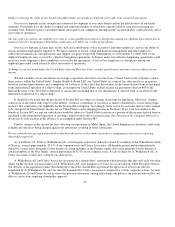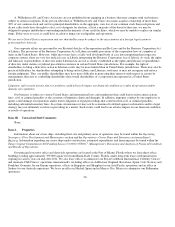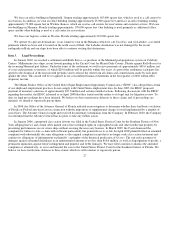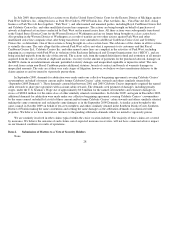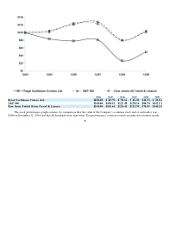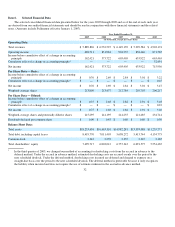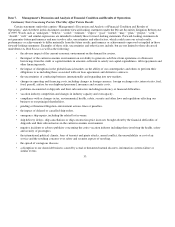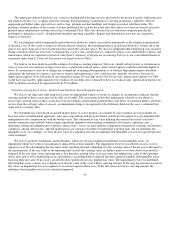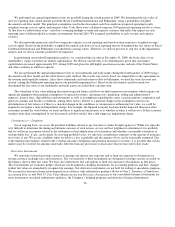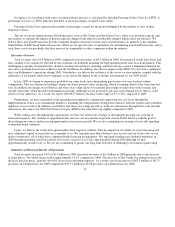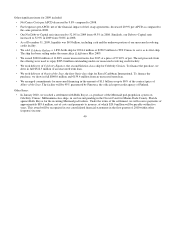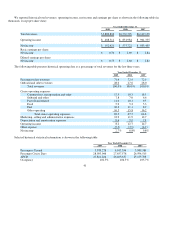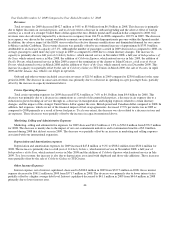Royal Caribbean Cruise Lines 2009 Annual Report Download - page 44
Download and view the complete annual report
Please find page 44 of the 2009 Royal Caribbean Cruise Lines annual report below. You can navigate through the pages in the report by either clicking on the pages listed below, or by using the keyword search tool below to find specific information within the annual report.
The above examples are not exhaustive and new risks emerge from time to time. We undertake no obligation to publicly update
or revise any forward-looking statements, whether as a result of new information, future events or otherwise.
Critical Accounting Policies
Our consolidated financial statements are prepared in accordance with accounting principles generally accepted in the United
States of America. (See Note 1. General and Note 2. Summary of Significant Accounting Policies to our consolidated financial
statements under Item 8. Financial Statements and Supplementary Data.) Certain of our accounting policies are deemed “critical,” as
they require management’s highest degree of judgment, estimates and assumptions. We have discussed these accounting policies and
estimates with the audit committee of our board of directors. We believe our most critical accounting policies are as follows:
Ship Accounting
Our ships represent our most significant assets and are stated at cost less accumulated depreciation. Depreciation of ships is
generally computed net of a 15% projected residual value using the straight-line method over estimated service lives of primarily 30
years. Our service life and residual value estimates take into consideration the impact of anticipated technological changes, long-term
cruise and vacation market conditions and historical useful lives of similarly-built ships. In addition, we take into consideration our
estimates of the average useful lives of the ships’ major component systems, such as hull, superstructure, main electric, engines and
cabins. Given the very large and complex nature of our ships, our accounting estimates related to ships and determinations of ship
improvement costs to be capitalized require considerable judgment and are inherently uncertain. We do not have cost segregation
studies performed to specifically componentize our ship systems; therefore, we estimate the costs of component systems based
principally on general and technical information known about major ship component systems and their lives and our knowledge of the
cruise vacation industry. We do not identify and track depreciation by ship component systems, but instead utilize these estimates to
determine the net cost basis of assets replaced or refurbished. Improvement costs that we believe add value to our ships are capitalized
as additions to the ship and depreciated over the improvements’ estimated useful lives. The estimated cost and accumulated
depreciation of replaced or refurbished ship components are written off and any resulting losses are recognized in cruise operating
expenses.
We use the deferral method to account for drydocking costs. Under the deferral method, drydocking costs incurred are deferred
and charged to expense on a straight-line basis over the period to the next scheduled drydock which we estimate to be a period of
thirty to sixty months based on the vessel’s age as required by class. Deferred drydock costs consist of the costs to drydock the vessel
and other costs incurred in connection with the drydock which are necessary to maintain the vessel’s Class certification. Class
certification is necessary in order for our cruise ships to be flagged in a specific country, obtain liability insurance and legally operate
as passenger cruise ships. The activities associated with those drydocking costs cannot be performed while the vessel is in service
and, as such, are done during a drydock as a planned major maintenance activity.
34
•
our ability to protect and differentiate our cruise brands,
•
changes or disruptions to the travel agency industry,
•
the loss of key personnel, strained collective bargaining relationships and/or our inability to retain or recruit qualified
personnel,
•
changes in our stock price or principal shareholders,
•
uncertainties of a foreign legal system as we are not incorporated in the United States,
•
the unavailability of ports of call,
•
weather.



